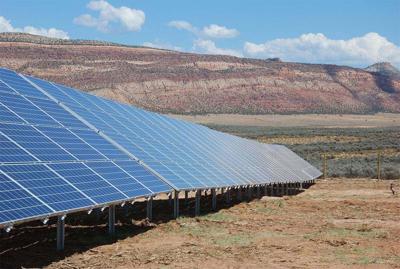San Miguel Power Association’s (SMPA) community solar farm in Paradox Valley is offline until further notice pending repairs.
SMPA CEO Brad Zaporski made the announcement during the July 25 SMPA Board of Directors meeting, citing a transformer failure.
“We found out there was an issue with a transformer on Monday (July 24),” said Wiley Freeman, Manager of Member and Energy Services for SMPA. “Because of those issues, we de-energized the solar array.”
The 1.1-megawatt solar array was constructed in 2012 on a seven-acre plot of land in the northeast corner of Paradox Valley. It is located on Highway 90 approximately 14 miles west of Naturita.
Megawatt is the term of measurement for bulk electricity. One megawatt is approximately one million watts.
The project, a joint effort by SMPA and the Clean Energy Collective, was the first community solar farm in Southwest Colorado.
Freeman said the solar array consists of 4,784 solar panels owned by 196 customers, including the Town of Telluride.
Each solar panel is 235 watts and generates approximately $45 worth of electricity per year.
A customer’s utility bill indicates how much electricity has been used in kilowatt-hours, and how much they pay for that electricity. A typical single solar panel generates about 2 kilowatt-hours (kWh) per day, saving an average of $0.36 on electricity costs per day.
Technicians are currently investigating the cause of the transformer failure and there is no current estimate on the time it will take to repair the solar array, Freeman said.
The SMPA serves 36,000 square miles in western Colorado and there are people from every community in between that subscribe to the community solar farm.
Subscribers receive a monthly credit on their bill based on the production output of the array, which changes depending on a number of different factors.
“Anytime the solar array is not producing power for any reason, it will affect the amount of the credit,” Freeman said. “If the array is down for maintenance, if it’s cloudy or when there are shorter days in the wintertime…it reduces the amount of the credit on the bill.”
In theory, if the outage lasts for more than a month, subscribers would receive no credit toward their bill for that month, Freeman said.
The life expectancy for most solar panels is 25 to 30 years. Freedman said the solar farm agreement lasts through 2032, although there is a “very good possibility the solar panels will still be functional at that time.”
If the solar array is still operational, leases will be renewed; otherwise, it will be decommissioned and the land will be returned to its former state.
Sunny southwest Colorado is an attractive location for solar farms, including two large ongoing projects in Montezuma and Dolores counties.
The 140-megawatt project in Montezuma County is 3.5 miles west of Arriola and will include 400,000 solar panels on 1,000 acres. Similar in size, the proposed 110-megawatt project in Dolores County will be constructed on 800 acres northwest of Cahone.
The maximum combined generation of 250 megawatts would serve the equivalent of 75,000 average homes annually.
The location of solar developments can be a major point of contention for residents. OneEnergy proposed the construction of a 100-megawatt solar farm on Wright’s Mesa, about two miles southwest of Norwood on undeveloped parcels of land along Lone Cone Road.
San Miguel County residents are pushing back against the proposed solar farm, because the area has wetlands and migratory wildlife.
The Clean Energy Collective declared bankruptcy in 2020 and SMPA took over ownership of the community solar farm in Paradox. Because SMPA owns, operates and maintains the solar array, there are no additional operation or maintenance costs for members who own solar panels.






